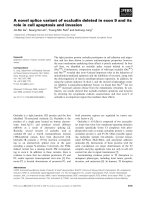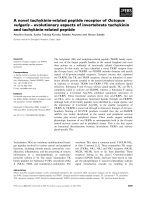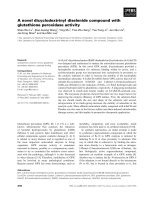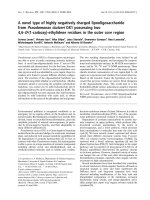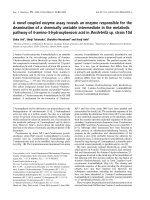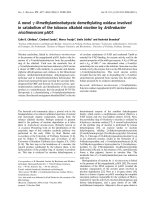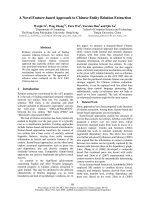Báo cáo khoa học: "A Novel Discourse Parser Based on Support Vector Machine Classification" docx
Bạn đang xem bản rút gọn của tài liệu. Xem và tải ngay bản đầy đủ của tài liệu tại đây (310.36 KB, 9 trang )
Proceedings of the 47th Annual Meeting of the ACL and the 4th IJCNLP of the AFNLP, pages 665–673,
Suntec, Singapore, 2-7 August 2009.
c
2009 ACL and AFNLP
A Novel Discourse Parser Based on
Support Vector Machine Classification
David A. duVerle
National Institute of Informatics
Tokyo, Japan
Pierre & Marie Curie University
Paris, France
Helmut Prendinger
National Institute of Informatics
Tokyo, Japan
Abstract
This paper introduces a new algorithm to
parse discourse within the framework of
Rhetorical Structure Theory (RST). Our
method is based on recent advances in the
field of statistical machine learning (mul-
tivariate capabilities of Support Vector
Machines) and a rich feature space. RST
offers a formal framework for hierarchical
text organization with strong applications
in discourse analysis and text generation.
We demonstrate automated annotation of
a text with RST hierarchically organised
relations, with results comparable to those
achieved by specially trained human anno-
tators. Using a rich set of shallow lexical,
syntactic and structural features from the
input text, our parser achieves, in linear
time, 73.9% of professional annotators’
human agreement F-score. The parser is
5% to 12% more accurate than current
state-of-the-art parsers.
1 Introduction
According to Mann and Thompson (1988), all
well-written text is supported by a hierarchically
structured set of coherence relations which reflect
the authors intent. The goal of discourse parsing
is to extract this high-level, rhetorical structure.
Dependency parsing and other forms of syn-
tactic analysis provide information on the gram-
matical structure of text at the sentential level.
Discourse parsing, on the other hand, focuses
on a higher-level view of text, allowing some
flexibility in the choice of formal representation
while providing a wide range of applications
in both analytical and computational linguistics.
Rhetorical Structure Theory (Mann and Thomp-
son, 1988) provides a framework to analyze and
study text coherence by defining and applying a set
of structural relations to composing units (‘spans’)
of text. Annotation of a text within the RST
formalism will produce a tree-like structure that
not only reflects text-coherence but also provides
input for powerful algorithmic tools for tasks such
as text regeneration (Piwek et al., 2007).
RST parsing can be seen as a two-step process:
1. Segmentation of the input text into elemen-
tary discourse units (‘edus’).
2. Generation of the rhetorical structure tree
based on ‘rhetorical relations’ (or ‘coherence
relations’) as labels of the tree, with the edus
constituting its terminal nodes.
Mann and Thompson (1988) empirically estab-
lished 110 distinct rhetorical relations, but pointed
out that this set was flexible and open-ended.
In addition to rhetorical relations, RST defines
the notion of ‘nucleus’, the relatively more
important part of the text, and ‘satellite’, which
is subordinate to the nucleus. In Fig. 1, the left-
most edu constitutes the satellite (indicated by
out-going arrow), and the right-hand statement
constitutes the nucleus. Observe that the nucleus
itself is a compound of nucleus and satellite.
Several attempts to automate discourse parsing
have been made. Marcu and Soricut focussed
on sentence-level parsing and developed two
probabilistic models that use syntactic and lexical
information (Soricut and Marcu, 2003). Although
their algorithm, called ‘SPADE’, does not produce
full-text parse, it demonstrates a correlation
between syntactic and discourse information, and
their use to identify rhetorical relations even if no
signaling cue words are present.
665
❘
TEMPORAL
After plummet-
ing 1.8% at one
point during the
day,
✠
CONTRAST
the composite re-
bounded a little,
but finished down
5.52, at 461.70.
Figure 1: Example of a simple RST tree (Source:
RST Discourse Treebank (Carlson et al., 2001),
wsj
0667
).
To the best of our knowledge, Reitter’s (2003b)
was the only previous research based exclusively
on feature-rich supervised learning to produce
text-level RST discourse parse trees. However,
his full outline for a working parser, using chart-
parsing-style techniques, was never implemented.
LeThanh et al. (2004) proposed a multi-step
algorithm to segment and organize text spans into
trees for each successive level of text organization:
first at sentence level, then paragraph and finally
text. The multi-level approach taken by their
algorithm mitigates the combinatorial explosion
effect without treating it entirely. At the text-level,
and despite the use of beam search to explore the
solution space, the algorithm needs to produce and
score a large number of trees in order to extract
the best candidate, leading, in our experience, to
impractical calculation times for large input.
More recently, Baldridge and Lascarides (2005)
successfully implemented a probabilistic parser
that uses headed trees to label discourse relations.
Restricting the scope of their research to texts in
dialog form exclusively, they elected to use the
more specific framework of Segmented Discourse
Representation Theory (Asher and Lascarides,
2003) instead of RST.
In this paper, we advanced the state-of-the-art
in general discourse parsing, with an implemented
solution that is computationally efficient and suf-
ficiently accurate for use in real-time interactive
applications. The rest of this paper is organized
as follows: Section 2 describes the general
architecture of our system along with the choices
we made with regard to supervised learning.
Section 3 explains the different characteristics of
the input text used to train our system. Section 4
presents our results, and Section 5 concludes the
paper.
2 Building a Discourse Parser
2.1 Assumptions and Restrictions
In our work, we focused exclusively on the second
step of the discourse parsing problem, i.e., con-
structing the RST tree from a sequence of edus that
have been segmented beforehand. The motivation
for leaving aside segmenting were both practical
– previous discourse parsing efforts (Soricut and
Marcu, 2003; LeThanh et al., 2004) already
provide alternatives for standalone segmenting
tools – and scientific, namely, the greater need for
improvements in labeling. Current state-of-the-art
results in automatic segmenting are much closer
to human levels than full structure labeling (F-
score ratios of automatic performance over gold
standard reported in LeThanh et al. (2004): 90.2%
for segmentation, 70.1% for parsing).
Another restriction is to use the reduced set
of 18 rhetorical relations defined in Carlson
et al. (2001) and previously used by Soricut
and Marcu (2003). In this set, the 75 re-
lations originally used in the RST Discourse
Treebank (RST-DT) corpus (Carlson et al.,
2001) are partitioned into 18 classes accord-
ing to rhetorical similarity (e.g.: PROBLEM-
SOLUTION, QUESTION-ANSWER, STATEMENT-
RESPONSE, TOPIC-COMMENT and COMMENT-
TOPIC are all grouped under one TOPIC-
COMMENT relation). In accord with previous
research (Soricut and Marcu, 2003; Reitter,
2003b; LeThanh et al., 2004), we turned all n-
ary rhetorical relations into nested binary relations
(a trivial graph transformation), resulting in more
algorithmically manageable binary trees. Finally,
we assumed full conformity to the ‘Principle of
sequentiality’ (Marcu, 2000), which guarantees
that only adjacent spans of text can be put
in relation within an RST tree, and drastically
reduces the size of the solution space.
2.2 Support Vector Machines
At the core of our system is a set of classifiers,
trained through supervised-learning, which, given
two consecutive spans (atomic edus or RST
sub-trees) in an input document, will score the
likelihood of a direct structural relation as well
as probabilities for such a relation’s label and
nuclearity. Using these classifiers and a straight-
forward bottom-up tree-building algorithm, we
can produce a valid tree close to human cross-
666
validation levels (our gold standard) in linear time-
complexity (see Fig. 2).
SVM Classification
Training Corpus
(RST-TB)
Test Corpus
Segmentation
(SPADE)
Penn
Treebank
Tokenized EDUs
EDUs
Lexicalized
Syntax Trees
Syntax Parsing (Charniak's nlparse)
Syntax Trees
Lexicalization
Lexicalization
Lexicalized
Syntax Trees
Syntax Trees
Alignment
Feature Extraction Alignment
Feature ExtractionSVM Training
SVM Models (Binary and Multiclass)
Bottom-up Tree Construction
Scored RS sub-trees
Rhetorical Structure Tree
Tokenization
Tokenized EDUs
Figure 2: Full system workflow.
In order to improve classification accuracy, it is
convenient to train two separate classifiers:
• S: A binary classifier, for structure (existence
of a connecting node between the two input
sub-trees).
• L: A multi-class classifier, for rhetorical
relation and nuclearity labeling.
Using our reduced set of 18 super-
relations and considering only valid
nuclearity options (e.g., (ATTRIBUTION, N, S)
and (ATTRIBUTION, S, N), but not
(ATTRIBUTION, N, N), as ATTRIBUTION is
a purely hypotactic relation group), we come up
with a set of 41 classes for our algorithm.
Support Vector Machines (SVM) (Vapnik,
1995) are used to model classifiers S and L. SVM
refers to a set of supervised learning algorithms
that are based on margin maximization. Given
our specific type of classification problem, SVMs
offer many properties of particular interest. First,
as maximum margin classifiers, they sidestep
the common issue of overfitting (Scholkopf et
al., 1995), and ensure a better control over
the generalization error (limiting the impact of
using homogeneous newspaper articles that could
carry important biases in prose style and lexical
content). Second, SVMs offer more resilience to
noisy input. Third, depending on the parameters
used (see the use of kernel functions below),
training time complexity’s dependence on feature
vector size is low, in some cases linear. This makes
SVM well-fitted to treat classification problems
involving relatively large feature spaces such as
ours (≈ 10
5
features). Finally, while most
probabilistic classifiers, such as Naive Bayes,
strongly assume feature independence, SVMs
achieve very good results regardless of input
correlations, which is a desirable property for
language-related tasks.
SVM algorithms make use of the ‘kernel
trick’ (Aizerman et al., 1964), a method for using
linear classifiers to solve non-linear problems.
Kernel methods essentially map input data to
a higher-dimensional space before attempting to
classify them. The choice of a fitting kernel
function requires careful analysis of the data and
must weigh the effects on both performance and
training time. A compromise needs to be found
during evaluation between the general efficiency
of non-linear kernels (such as polynomial or
Radial Basis Function) and low time-complexity
of using a linear function (see Sect. 4).
Because the original SVM algorithms build bi-
nary classifiers, multi-label classification requires
some adaptation. A possible approach is to
reduce the multi-classification problem through a
set of binary classifiers, each trained either on
a single class (“one vs. all”) or by pair (“one
vs. one”). Recent research suggests keeping the
classification whole, with a reformulation of the
original optimization problem to accommodate
multiple labels (“C & S”) (Crammer and Singer,
2002).
2.3 Input Data and Feature Extraction
Both S and L classifiers are trained using
manually annotated documents taken from the
RST-DT corpus. Optimal parameters (when
applicable) for each kernel function are obtained
through automated grid search with n-fold cross-
validation (Staelin, 2003) on the training corpus,
while a separate test set is used for performance
evaluation. In training mode, classification
instances are built by parsing manually annotated
trees from the RST-DT corpus paired with
lexicalized syntax trees (LS Trees) for each
sentence (see Sect. 3). Syntax trees are taken
667
directly from the Penn Treebank corpus (which
covers a superset of the RST-DT corpus), then
“lexicalized” (i.e. tagged with lexical “heads” on
each internal node of the syntactic tree) using a
set of canonical head-projection rules (Magerman,
1995; Collins, 2003). Due to small differences
in the way they were tokenized and pre-treated,
rhetorical tree and LST are rarely a perfect match:
optimal alignment is found by minimizing edit
distances between word sequences.
2.4 Tree-building Algorithm
By repeatedly applying the two classifiers and
following a naive bottom-up tree-construction
method, we are able to obtain a globally satisfying
RST tree for the entire text with excellent time-
complexity.
The algorithm starts with a list of all atomic
discourse sub-trees (made of single edus in their
text order) and recursively selects the best match
between adjacent sub-trees (using binary classifier
S), labels the newly created sub-tree (using multi-
label classifier L) and updates scoring for S, until
only one sub-tree is left: the complete rhetorical
parse tree for the input text.
It can be noted that, thanks to the principle
of sequentiality (see Sect. 2.1), each time two
sub-trees are merged into a new sub-tree, only
connections with adjacent spans on each side are
affected, and therefore, only two new scores need
to be computed. Since our SVM classifiers work
in linear time, the overall time-complexity of our
algorithm is O(n).
3 Features
Instrumental to our system’s performance is
the choice of a set of salient characteristics
(“features”) to be used as input to the SVM
algorithm for training and classification. Once the
features are determined, classification instances
can be formally represented as a vector of values
in R.
We use n-fold validation on S and L classifiers
to assess the impact of some sets of features
on general performance and eliminate redundant
features. However, we worked under the (verified)
assumption that SVMs’ capacity to handle high-
dimensional data and resilience to input noise limit
the negative impact of non-useful features.
In the following list of features, obtained
empirically by trial-and-error, features suffixed by
‘S[pan]’ are sub-tree-specific features, symmetri-
cally extracted from both left and right candidate
spans. Features suffixed by ‘F[ull]’ are a function
of the two sub-trees considered as a pair. Multi-
label features are turned into sets of binary values
and trees use a trivial fixed-length binary encoding
that assumes fixed depth.
3.1 Textual Organization
As evidenced by a number of discourse-parsing ef-
forts focusing on intra-sentential parsing (Marcu,
2000; Soricut and Marcu, 2003), there is a strong
correlation between different organizational levels
of textual units and sub-trees of the RST tree
both at the sentence-level and the paragraph level.
Although such correspondences are not a rule
(sentences and particularly paragraphs, can often
be found split across separate sub-trees), they
provide valuable high-level clues, particularly in
the task of scoring span relation priority (classifier
S):
Ex.: “Belong to same sentence”
F
, “Belong
to same paragraph”
F
, “Number of paragraph
boundaries”
S
, “Number of sentence bound-
aries”
S
. . .
As pointed out by Reitter (Reitter, 2003a), we
can hypothesize a correlation between span length
and some relations (for example, the satellite in a
CONTRAST relation will tend to be shorter than
the nucleus). Therefore, it seems useful to encode
different measures of span size and positioning,
using either tokens or edus as a distance unit:
Ex.: “Length in tokens”
S
, “Length in edus”
S
,
“Distance to beginning of sentence in tokens”
S
,
“Size of span over sentence in edus”
S
, “Distance
to end of sentence in tokens”
S
. . .
In order to better adjust to length variations
between different types of text, some features in
the above set are duplicated using relative, rather
than absolute, values for positioning and distance.
3.2 Lexical Clues and Punctuation
While not always present, discourse markers
(connectives, cue-words or cue-phrases, etc) have
been shown to give good indications on discourse
structure and labeling, particularly at the sentence-
level (Marcu, 2000). We use an empirical n-
gram dictionary (for n ∈ {1, 2, 3}) built from the
training corpus and culled by frequency. As an
advantage over explicit cue-words list, this method
668
also takes into account non-lexical signals such
as punctuation and sentence/paragraph boundaries
(inserted as artificial tokens in the original text
during input formatting) which would otherwise
necessitate a separate treatment.
We counted and encoded n-gram occurrences
while considering only the first and last n tokens
of each span. While raising the encoding size
compared to a “bag of words” approach, this
gave us significantly better performance (classifier
accuracy improved by more than 5%), particularly
when combined with main constituent features
(see Sect. 3.5 below). This is consistent with the
suggestion that most meaningful rhetorical signals
are located on the edge of the span (Schilder,
2002).
We validated this approach by comparing
it to results obtained with an explicit list
of approximately 300 discourse-signaling cue-
phrases (Oberlander et al., 1999): performance
when using the list of cue-phrases alone was
substantially lower than n-grams.
3.3 Simple Syntactic Clues
In order to complement signal detection and to
achieve better generalization (smaller dependency
on lexical content), we opted to add shallow
syntactic clues by encoding part-of-speech (POS)
tags for both prefix and suffix in each span. Using
prefixes or suffixes of length higher than n = 3 did
not seem to improve performance significantly.
3.4 Dominance Sets
A promising concept introduced by Soricut and
Marcu (2003) in their sentence-level parser is the
identification of ‘dominance sets’ in the syntax
parse trees associated to each input sentence. For
example, it could be difficult to correctly identify
the scope of the ATTRIBUTION relation in the
example shown in Fig. 3. By using the associated
syntax tree and studying the sub-trees spanned by
each edu (see Fig. 4), it is possible to quickly infer
a logical nesting order (“dominance”) between
them: 1A > 1B > 1C. This order allows us
to favor the relation between 1B and 1C over a
relation between 1A and 1B, and thus helps us
to make the right structural decision and pick the
right-hand tree on Fig. 3.
In addition to POS tags around the frontier
between each dominance set (see colored nodes
in Fig. 4), Soricut and Marcu (2003) note that in
order to achieve good results on relation labeling,
[Shoney’s Inc. said]
1A
[it will report a write-off
of $2.5 million, or seven cents a share, for its
fourth quarter]
1B
[ended yesterday.]
1C
(wsj
0667
)
✠
ELABORATION
❘
ATTRIBUTION
1A 1B
1C
❘
ATTRIBUTION
1A
✠
ELABORATION
1B 1C
Figure 3: Two possible RST parses for a sentence.
it is necessary to also consider lexical informa-
tion (obtained through head word projection of
terminal nodes to higher internal nodes). Based
on this definition of dominance sets, we include a
set of syntactic, lexical and tree-structural features
that aim at a good approximation of Marcu &
Soricut’s rule-based analysis of dominance sets
while keeping parsing complexity low.
Ex.: “Distance to root of the syntax tree”
S
,
“Distance to common ancestor in the syn-
tax tree”
S
, “Dominating node’s lexical head
in span”
S
, “Common ancestor’s POS tag”
F
,
“Common ancestor’s lexical head”
F
, “Domi-
nating node’s POS tag”
F
(diamonds in Figure
4, “Dominated node’s POS tag”
F
(circles in
Figure 4), “Dominated node’s sibling’s POS
tag”
F
(rectangles in Figure 4), “Relative position
of lexical head in sentence”
S
. . .
3.5 Strong Compositionality Criterion
We make use of Marcu’s ‘Strong Compositionality
Criterion’ (Marcu, 1996) through a very simple
and limited set of features, replicating shallow lex-
ical and syntactic features (previously described in
Sections 3.2 and 3.3) on a single representative
edu (dubbed main constituent) for each span.
Main constituents are selected recursively using
nuclearity information. We purposely keep
the number of features extracted from main
constituents comparatively low (therefore limiting
the extra dimensionality cost), as we believe our
use of rhetorical sub-structures ultimately encodes
a variation of Marcu’s compositionality criterion
(see Sect. 3.6).
3.6 Rhetorical Sub-structure
A large majority of the features considered so far
focus exclusively on sentence-level information.
669
1A.
1B.
1C.
S
NP-SBJ
NP
NNP
Shoney
POS
's
NNP
Inc.
VP
VBD
said
SBAR
S
NP-SBJ
PRP
it
VP
MD
will
VP
VB
report
NP
NP
DT
a
NN
write-off
PP
IN
of
NP
NP
QP
$
$
CD
2.5
CD
million
,
,
CC
or
NP
NP
CD
seven
NNS
cents
NP-ADV
DT
a
NN
share
,
,
PP
IN
for
NP
NP
PRP$
its
JJ
fourth
NN
quarter
VP
VBN
ended
NP-TMP
NN
yesterday
.
.
(said)
(will)
(quarter)
(ended)
(quarter)
(said)
(said)
(will)(it)
Figure 4: Using dominance sets to prioritize structural relations.
Circled nodes define dominance sets and studying the frontiers between circles and diamonds gives us a dominance order
between each of the three sub-trees considered: 1A > 1B > 1C. Head words obtained through partial lexicalization have been
added between parenthesis.
In order to efficiently label higher-level relations,
we need more structural features that can guide
good classification decision on large spans. Hence
the idea of encoding each span’s rhetorical subtree
into the feature vector seems natural.
Beside the role of nuclearity in the sub-structure
implied by Marcu’s compositionality criterion (see
Sect. 3.5), we expect to see certain correlations
between the relation being classified and relation
patterns in either sub-tree, based on theoretical
considerations and practical observations. The
original RST theory suggests the use of ‘schemas’
as higher-order patterns of relations motivated by
linguistic theories and verified through empirical
analysis of annotated trees (Mann and Thompson,
1988). In addition, some level of correlation
between relations at different levels of the tree
can be informally observed throughout the corpus.
This is trivially the case for n-ary relations
such as LIST which have been binarized in our
representation, i.e., the presence of several LIST
relations in rightmost nodes of a subtree greatly
increases the probability that the parent relation
might be a LIST itself.
4 Evaluation
4.1 General Considerations
In looking to evaluate the performance of our
system, we had to work with a number of
constraints and difficulties tied to variations in the
methodologies used across past works, as well
as a lack of consensus with regard to a common
evaluation corpus. In order to accommodate these
divergences while providing figures to evaluate
both relative and absolute performance of our
algorithm, we used three different test sets.
Absolute performance is measured on the official
test subset of the RST-DT corpus. A similarly
available subset of doubly-annotated documents
from the RST-DT is used to compare results
with human agreement on the same task. Lastly,
performance against past algorithms is evaluated
with another subset of the RST-DT, such as used
by LeThanh et al. (2004) in their own evaluation.
4.2 Raw SVM Classification
Although our final goal is to achieve good
performance on the entire tree-building task, a
useful intermediate evaluation of our system can
be conducted by measuring raw performance of
SVM classifiers. Binary classifier S is trained
on 52,683 instances (split approximately 1/3,
2/3 between positive and negative examples),
extracted from 350 documents, and tested on
8,558 instances extracted from 50 documents. The
feature space dimension is 136,987. Classifier L
is trained on 17,742 instances (labeled across 41
classes) and tested on 2,887 instances, of same
dimension as for S.
Classifier: Binary (S) Multi-label (L) Reitter
Kernel Linear Polyn. RBF Linear RBF RBF
Software liblinear svm
light
svm
light
svm
multiclass
libsvm svm
light
Multi-label - C&S 1 vs. 1 1 vs. all
Training time 21.4s 5m53s 12m 15m 23m 216m
Accuracy 82.2 85.0 82.9 65.8 66.8 61.0
Table 1: SVM Classifier performance. Regarding
‘Multi-label’, see Sect. 2.2.
The noticeably good performance of linear
670
kernel methods in the results presented in Table 1
compared to more complex polynomial and RBF
kernels, would indicate that our data separates
fairly well linearly: a commonly observed effect
of high-dimensional input (Chen et al., 2007) such
as ours (> 100,000 features).
A baseline for absolute comparison on the
multi-label classification task is given by Reit-
ter (2003a) on a similar classifier, which assumes
perfect segmentation of the input, as ours does.
Reitter’s accuracy results of 61% match a smaller
set of training instances (7976 instances from
240 documents compared to 17,742 instances in
our case) but with considerably less classes (16
rhetorical relation labels with no nuclearity, as
opposed to our 41 nuclearized relation classes).
Based on these differences, this sub-component of
our system, with an accuracy of 66.8%, seems to
perform well.
Taking into account matters of performance and
runtime complexity, we selected a linear kernel for
S and an optimally parameterized RBF kernel for
L, using modified versions of the liblinear and
libsvm software packages. All further evaluations
noted here were conducted with these.
4.3 Full System Performance
A measure of our full system’s performance is
realized by comparing structure and labeling of
the RST tree produced by our algorithm to that
obtained through manual annotation (our gold
standard). Standard performance indicators for
such a task are precision, recall and F-score as
measured by the PARSEVAL metrics (Black et al.,
1991), with the specific adaptations to the case of
RST trees made by Marcu (2000, page 143-144).
Our first evaluation (see Table 2) was conducted
using the standard test subset of 41 files provided
by the RST-DT corpus. In order to more
accurately compare our results to the gold standard
(defined as manual agreement between human
annotators), we also evaluated performance using
the 52 doubly-annotated files present in the RST-
DT as test set (see Table 3). In each case, the
remaining 340–350 files are used for training.
For each corpus evaluation, the system is
run twice: once using perfectly-segmented in-
put (taken from the RST-DT), and once using
the output of the SPADE segmenter (Soricut and
Marcu, 2003). The first measure gives us a good
idea of our system’s optimal performance (given
optimal input), while the other gives us a more
real-world evaluation, apt for comparison with
other systems.
In each case, parse trees are evaluated using the
four following, increasingly complex, matching
criteria: blank tree structure (‘S’), tree structure
with nuclearity (‘N’), tree structure with rhetorical
relations (‘R’) and our final goal: fully labeled
structure with both nuclearity and rhetorical
relation labels (‘F’).
Segment. Manual SPADE
S N R F S N R F
Precision 83.0 68.4 55.3 54.8 69.5 56.1 44.9 44.4
Recall 83.0 68.4 55.3 54.8 69.2 55.8 44.7 44.2
F-Score 83.0 68.4 55.3 54.8 69.3 56.0 44.8 44.3
Table 2: Discourse-parser evaluation depending
on segmentation using standard test subset
System performance Human agreement
Segment. Manual SPADE -
S N R F S N R F S N R F
Precision 84.1 70.6 55.6 55.1 70.6 58.1 46.0 45.6 88.0 77.5 66.0 65.2
Recall 84.1 70.6 55.6 55.1 71.2 58.6 46.4 46.0 88.1 77.6 66.1 65.3
F-Score 84.1 70.6 55.6 55.1 70.9 58.3 46.2 45.8 88.1 77.5 66.0 65.3
Table 3: Comparing to human-agreement de-
pending on segmentation using doubly-annotated
subset
Note: When using perfect segmentation, preci-
sion and recall are identical since both trees have
same number of constituents.
4.4 Comparison with other Algorithms
To the best of our knowledge, only two fully
functional text-level discourse parsing algorithms
for general text have published their results:
Marcu’s decision-tree-based parser (Marcu, 2000)
and the multi-level rule-based system built by
LeThanh et al. (2004). For each one, evaluation
was conducted on a different corpus, using
unavailable documents for Marcu’s and a selection
of 21 documents from the RST-DT (distinct
from RST-DT’s test set) for LeThanh’s. We
therefore retrained and evaluated our classifier,
using LeThanh’s set of 21 documents as testing
subset (and the rest for training) and compared
performance (see Table 4). In order to achieve
the most uniform conditions possible, we use
LeThanh’s results on 14 classes (Marcu’s use 15,
ours 18) and select SPADE segmentation figures
for both our system and Marcu’s (LeThanh’s
671
system uses its own segmenter and does not
provide figures for perfectly segmented input).
Structure Nuclearity Relations
Algorithm M lT dV M lT dV M lT dV
Precision 65.8 54.5 72.4 54.0 47.8 57.8 34.3 40.5 47.8
Recall 34.0 52.9 73.3 21.6 46.4 58.5 13.0 39.3 48.4
F-score 44.8 53.7 72.8 30.9 47.1 58.1 18.8 39.9 48.1
Table 4: Side-by-side text-level algorithms com-
parison: Marcu (M), LeThanh et al. (lT) and ours
(dV)
Some discrepancies between reported human
agreement F-scores suggest that, despite our
best efforts, evaluation metrics used by each
author might differ. Another explanation may lie
in discrepancies between training/testing subsets
used. In order to take into account possibly
varying levels of difficulties between corpora, we
therefore divided each F-score by the value for
human agreement, such as measured by each
author (see Table 5). This ratio should give us a
fairer measure of success for the algorithm taking
into account how well it succeeds in reaching near-
human level.
Structure Nuclearity Relations
Algorithm M lT dV M lT dV M lT dV
F−score
algo
F−score
human
56.0 73.9 83.0 42.9 71.8 75.6 25.7 70.1 73.9
Table 5: Performance scaled by human agreement
scores: Marcu (M), LeThahn et al. (lT) and ours
(dV)
Table 5 shows 83%, 75.6% and 73.9% of human
agreement F-scores in structure, nuclearity and
relation parsing, respectively. Qualified by the
(practical) problems of establishing comparison
conditions with scientific rigor, the scores indicate
that our system outperforms the previous state-
of-the-art (LeThanh’s 73.9%, 71.8% and 70.1%).
As suggested by previous research (Soricut and
Marcu, 2003), these scores could likely be
further improved with the use of better-performing
segmenting algorithms. It can however be noted
that our system seems considerably less sensitive
to imperfect segmenting than previous efforts. For
instance, when switching from manual segmen-
tation to automatic, our performance decreases
by 12.3% and 12.9% (respectively for structure
and relation F-scores) compared to 46% and 67%
for Marcu’s system (LeThanh’s performance on
perfect input is unknown).
5 Conclusions and Future Work
In this paper, we have shown that it is possible
to build an accurate automatic text-level discourse
parser based on supervised machine-learning
algorithms, using a feature-driven approach and
a manually annotated corpus. Importantly, our
system achieves its accuracy in linear complexity
of the input size with excellent runtime per-
formance. The entire test subset in the RST-
DT corpus could be fully annotated in a matter
of minutes. This opens the way to many
novel applications in real-time natural language
processing and generation, such as the RST-based
transformation of monological text into dialogues
acted by virtual agents in real-time (Hernault et al.,
2008).
Future directions for this work notably include
a better tree-building algorithm, with improved
exploration of the solution space. Borrowing
techniques from generic global optimization meta-
algorithms such as simulated annealing (Kirk-
patrick et al., 1983) should allow us to better
deal with issues of local optimality while retaining
acceptable time-complexity.
A complete online discourse parser, incorpo-
rating the parsing tool presented above com-
bined with a new segmenting method has since
been made freely available at http://nlp.
prendingerlab.net/hilda/.
Acknowledgements
This project was jointly funded by Prendinger
Lab (NII, Tokyo) and the National Institute
for Informatics (Tokyo), as part of a MOU
(Memorandum of Understanding) program with
Pierre & Marie Curie University (Paris).
672
References
M.A. Aizerman, E.M. Braverman, and L.I. Rozonoer.
1964. Theoretical foundations of the potential
function method in pattern recognition learning.
Automation and Remote Control, 25(6):821–837.
N. Asher and A. Lascarides. 2003. Logics of
conversation. Cambridge University Press.
J. Baldridge and A. Lascarides. 2005. Probabilistic
head-driven parsing for discourse structure. In Pro-
ceedings of the Ninth Conference on Computational
Natural Language Learning, volume 96, page 103.
E. Black, S. Abney, S. Flickenger, C. Gdaniec,
C. Grishman, P. Harrison, D. Hindle, R. Ingria,
F. Jelinek, J. Klavans, M. Liberman, et al. 1991.
Procedure for quantitatively comparing the syntactic
coverage of English grammars. Proceedings of the
workshop on Speech and Natural Language, pages
306–311.
L. Carlson, D. Marcu, and M.E. Okurowski. 2001.
Building a discourse-tagged corpus in the frame-
work of Rhetorical Structure Theory. Proceedings
of the Second SIGdial Workshop on Discourse and
Dialogue-Volume 16, pages 1–10.
D. Chen, Q. He, and X. Wang. 2007. On
linear separability of data sets in feature space.
Neurocomputing, 70(13-15):2441–2448.
M. Collins. 2003. Head-Driven Statistical Models
for Natural Language Parsing. Computational
Linguistics, 29(4):589–637.
K. Crammer and Y. Singer. 2002. On the algorithmic
implementation of multiclass kernel-based vector
machines. The Journal of Machine Learning
Research, 2:265–292.
H. Hernault, P. Piwek, H. Prendinger, and M. Ishizuka.
2008. Generating dialogues for virtual agents using
nested textual coherence relations. Proceedings
of the 8th International Conference on Intelligent
Virtual Agents (IVA’08), LNAI, 5208:139–145, Sept.
S. Kirkpatrick, CD Gelatt, and MP Vecchi. 1983.
Optimization by Simulated Annealing. Science,
220(4598):671–680.
H. LeThanh, G. Abeysinghe, and C. Huyck. 2004.
Generating discourse structures for written texts.
Proceedings of the 20th international conference on
Computational Linguistics.
D.M. Magerman. 1995. Statistical decision-tree
models for parsing. Proceedings of the 33rd
annual meeting on Association for Computational
Linguistics, pages 276–283.
W.C. Mann and S.A. Thompson. 1988. Rhetorical
structure theory: Toward a functional theory of text
organization. Text, 8(3):243–281.
D. Marcu. 1996. Building Up Rhetorical Structure
Trees. Proceedings of the National Conference on
Artificial Intelligence, pages 1069–1074.
D. Marcu. 2000. The theory and practice of discourse
parsing and summarization. MIT Press.
J. Oberlander, J.D. Moore, J. Oberlander, A. Knott,
and J. Moore. 1999. Cue phrases in discourse:
further evidence for the core: contributor distinction.
Proceedings of the 1999 Levels of Representation in
Discourse Workshop (LORID’99), pages 87–93.
P. Piwek, H. Hernault, H. Prendinger, and M. Ishizuka.
2007. Generating dialogues between virtual agents
automatically from text. Proceedings of the
7th International Conference on Intelligent Virtual
Agents (IVA ’07), LNCS, 4722:161.
D. Reitter. 2003a. Rhetorical Analysis with Rich-
Feature Support Vector Models. Unpublished
Master’s thesis, University of Potsdam, Potsdam,
Germany.
D. Reitter. 2003b. Simple Signals for Complex
Rhetorics: On Rhetorical Analysis with Rich-
Feature Support Vector Models. Language, 18(52).
F. Schilder. 2002. Robust discourse parsing via
discourse markers, topicality and position. Natural
Language Engineering, 8(2-3):235–255.
B. Scholkopf, C. Burges, and V. Vapnik. 1995. Ex-
tracting Support Data for a Given Task. Knowledge
Discovery and Data Mining, pages 252–257.
R. Soricut and D. Marcu. 2003. Sentence
level discourse parsing using syntactic and lexical
information. Proceedings of the 2003 Conference
of the North American Chapter of the Association
for Computational Linguistics on Human Language
Technology, 1:149–156.
C. Staelin. 2003. Parameter selection for support
vector machines. Hewlett-Packard Company, Tech.
Rep. HPL-2002-354R1.
V.N. Vapnik. 1995. The nature of statistical learning
theory. Springer-Verlag New York, Inc., New York,
NY, USA.
673

